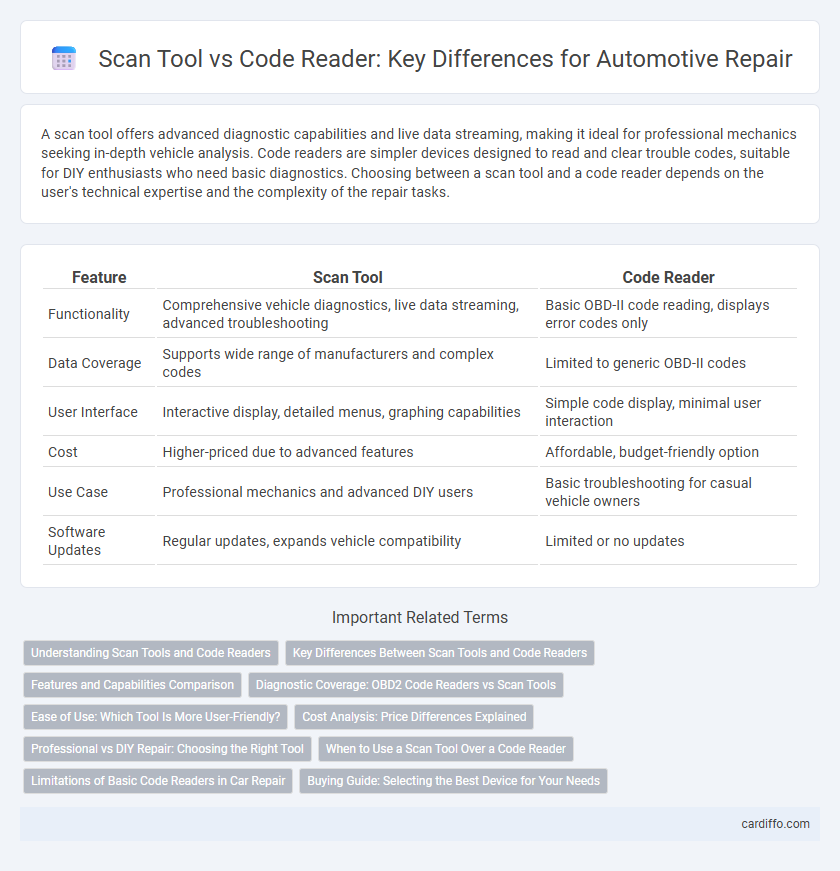A scan tool offers advanced diagnostic capabilities and live data streaming, making it ideal for professional mechanics seeking in-depth vehicle analysis. Code readers are simpler devices designed to read and clear trouble codes, suitable for DIY enthusiasts who need basic diagnostics. Choosing between a scan tool and a code reader depends on the user's technical expertise and the complexity of the repair tasks.
Table of Comparison
| Feature | Scan Tool | Code Reader |
|---|---|---|
| Functionality | Comprehensive vehicle diagnostics, live data streaming, advanced troubleshooting | Basic OBD-II code reading, displays error codes only |
| Data Coverage | Supports wide range of manufacturers and complex codes | Limited to generic OBD-II codes |
| User Interface | Interactive display, detailed menus, graphing capabilities | Simple code display, minimal user interaction |
| Cost | Higher-priced due to advanced features | Affordable, budget-friendly option |
| Use Case | Professional mechanics and advanced DIY users | Basic troubleshooting for casual vehicle owners |
| Software Updates | Regular updates, expands vehicle compatibility | Limited or no updates |
Understanding Scan Tools and Code Readers
Scan tools offer advanced diagnostic capabilities by accessing live data streams, performing active tests, and supporting manufacturer-specific codes, making them ideal for in-depth vehicle repair and troubleshooting. Code readers primarily retrieve and clear generic and some manufacturer-specific trouble codes but lack live data and extensive functionalities, making them suitable for basic diagnostics. Understanding the differences between scan tools and code readers enables repair professionals to select the appropriate device based on the complexity of the diagnostic task.
Key Differences Between Scan Tools and Code Readers
Scan tools offer advanced diagnostics by accessing live data streams, freeze frame data, and enhanced vehicle-specific codes, whereas code readers primarily retrieve and clear basic trouble codes. Scan tools enable live sensor data monitoring and detailed system testing, providing comprehensive insights for complex repairs. Code readers serve as entry-level devices suitable for simple fault identification but lack the depth and functionality found in full-featured scan tools.
Features and Capabilities Comparison
Scan tools offer advanced diagnostic capabilities, including live data streaming, bi-directional control, and comprehensive system coverage across various vehicle makes and models. Code readers provide basic functionality, primarily reading and clearing trouble codes, and are limited to engine codes without access to enhanced systems like ABS or transmission diagnostics. Professionals prefer scan tools for in-depth analysis and repair efficiency, while code readers suit casual users seeking quick fault code identification.
Diagnostic Coverage: OBD2 Code Readers vs Scan Tools
OBD2 code readers provide basic diagnostic coverage by reading generic and manufacturer-specific trouble codes, suitable for identifying common engine and emission issues. Scan tools offer comprehensive diagnostic coverage, accessing multiple vehicle systems such as ABS, airbag, transmission, and enhanced manufacturer-specific codes, enabling advanced troubleshooting and live data analysis. The expanded functionality of scan tools supports detailed diagnostics and repairs, reducing diagnostic time and improving accuracy for professional and DIY mechanics.
Ease of Use: Which Tool Is More User-Friendly?
Scan tools offer a more user-friendly experience with intuitive interfaces and real-time data visualization, making them ideal for both professionals and DIY enthusiasts. Code readers, though simpler and more affordable, provide basic diagnostic codes without extensive guidance or live data, which can limit ease of use for beginners. Investing in a scan tool enhances repair efficiency through detailed insights and straightforward navigation, streamlining the troubleshooting process.
Cost Analysis: Price Differences Explained
Scan tools typically cost significantly more than basic code readers, with prices ranging from $100 to over $1,000 compared to $20 to $100 for code readers. Scan tools offer advanced diagnostics, live data streaming, and comprehensive vehicle coverage, justifying the higher investment for professional mechanics. Code readers serve as affordable solutions for simple error code retrieval and basic vehicle troubleshooting, making them ideal for casual users.
Professional vs DIY Repair: Choosing the Right Tool
Professional mechanics rely on advanced scan tools that provide comprehensive diagnostics, live data streams, and bi-directional control, essential for accurate vehicle repair and system reprogramming. DIY enthusiasts often prefer code readers for their simplicity, affordability, and ease of use, primarily focusing on reading and clearing basic diagnostic trouble codes. Selecting between a scan tool and code reader depends on repair complexity, diagnostic needs, and technical expertise, ensuring optimal efficiency and cost-effectiveness in vehicle maintenance.
When to Use a Scan Tool Over a Code Reader
Choose a scan tool over a code reader when comprehensive vehicle diagnostics are required, as scan tools provide live data, freeze frame analysis, and advanced system tests beyond simple code retrieval. Scan tools support multiple protocols and offer bi-directional controls to actively test components, essential for complex repairs and accurate troubleshooting. For professional mechanics and serious repairs, the enhanced capabilities of a scan tool enable faster, more precise diagnostics, saving time and reducing guesswork compared to basic code readers.
Limitations of Basic Code Readers in Car Repair
Basic code readers offer limited diagnostic information by retrieving only generic trouble codes, which often lack detailed data necessary for accurate automotive repair. These tools cannot access advanced system parameters, freeze frame data, or manufacturer-specific codes, restricting their usefulness in complex vehicle diagnostics. Professional scan tools provide comprehensive system analysis, including live data streams and bi-directional control, essential for precise fault identification and efficient car repair.
Buying Guide: Selecting the Best Device for Your Needs
When selecting the best diagnostic device, understanding the difference between a scan tool and a code reader is crucial; scan tools offer comprehensive vehicle diagnostics, including live data streams and enhanced manufacturer-specific codes, while code readers provide basic trouble code reading and clearing capabilities. Prioritize compatibility with your vehicle's make, model, and year, alongside features like real-time data, OBD-II support, and update frequency to ensure long-term utility. Consider budget, ease of use, and additional functionalities such as ABS and SRS diagnostics to align the device with your repair needs.
Scan tool vs code reader Infographic

 cardiffo.com
cardiffo.com